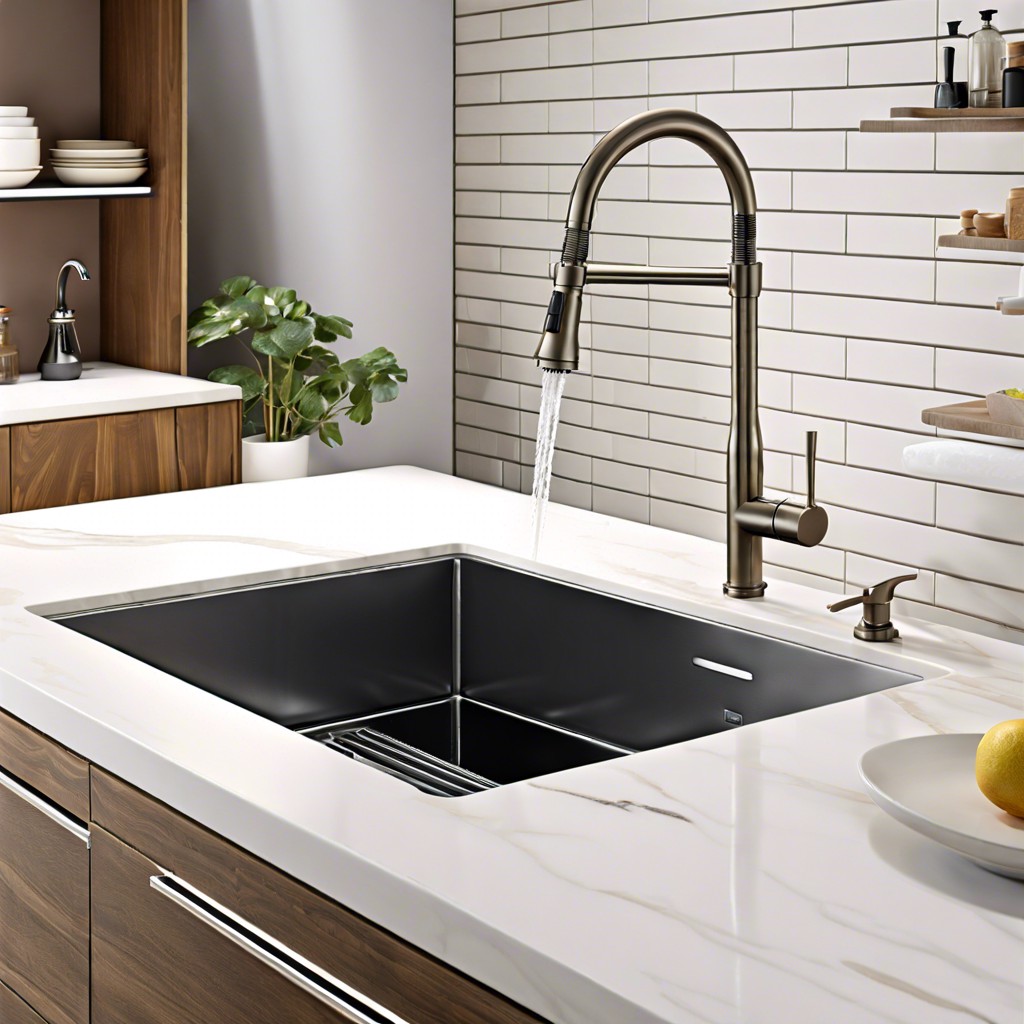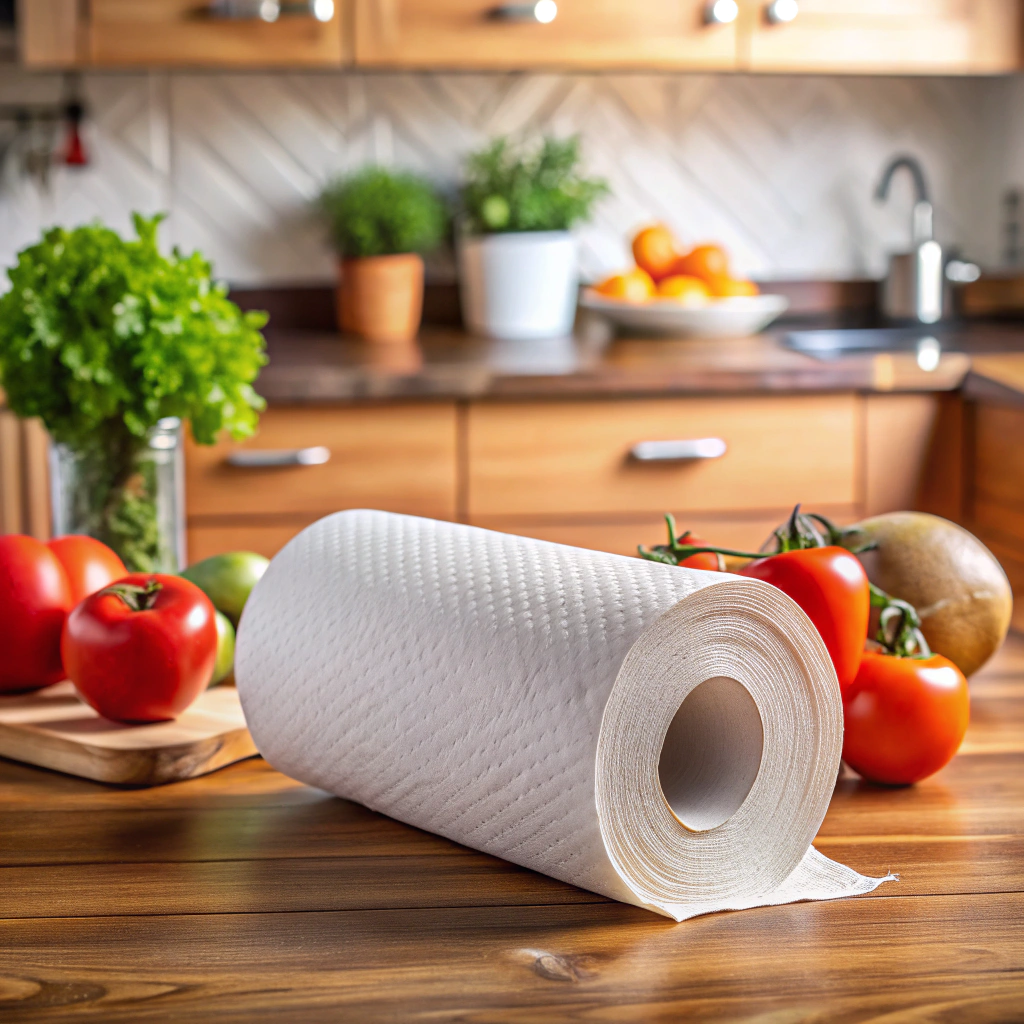Last updated on
Discover how to choose the perfect kitchen faucet that combines style, functionality, and budget-friendly options.
Choosing a kitchen faucet might seem like a small task, but oh boy, it can spiral into a head-scratching dilemma faster than you can say “leaky faucet.” Whether you’re in the midst of a full kitchen remodel or just need an upgrade, this guide will cover every detail you never knew you needed to consider: faucet types, handle configurations, and even those little extra features that can make your kitchen sing! Stay with me, and you’ll be the faucet-choosing maestro in no time.
Key takeaways:
- Choose faucet type wisely for functionality and style.
- Consider handle types for ease of use and aesthetic.
- Think about spout and sprayer configurations based on needs.
- Select a finish that complements kitchen style and maintenance habits.
- Ensure faucet installation matches sink hole configuration and required features.
What's Inside
Faucet Types

Let’s dive into the wonderful world of faucet varieties. Think of it as choosing the lead actor in your kitchen’s blockbuster movie. First up, there’s the classic single-handle faucet, your kitchen’s equivalent of a reliable best friend. Easy to use, simple to install, and requiring just one hand to adjust hot and cold water.
Next, we have the double-handle faucet. Picture a sophisticated duo in a romantic drama. One handle for hot, one for cold. It gives you precision and control, plus it adds a touch of elegance.
Pull-down faucets are like the action heroes of the kitchen world. Pull the sprayer down to get those pots filled and vegetables washed, all with ease and flair. Pull-out faucets are their flexible, go-getter sidekicks, with a sprayer that pulls straight out, perfect for multitasking.
Bridge faucets bring a vintage charm, reminding you of grand kitchens from classic movies. The hot and cold taps connect through a horizontal bar, a nostalgic nod to the past with modern plumbing benefits.
Lastly, there’s a pot filler, the cameo star specifically designed for filling big pots right on the stove. Saves you from the hide-and-seek game with heavy cookware.
Ready to pick your faucet star? Let’s move on to handle types, where the plot gets even more exciting.
Handle Types
One handle or two handles? That’s the question! Single-handle faucets offer sleek design and simple control. Turn or tilt the lever to adjust both water temperature and flow. They’re perfect if you’re always in a rush, trying to get through your morning routine with one hand while wrangling toast or a toddler with the other.
Two-handle faucets bring a bit of classic charm and precise control to your kitchen. One handle for hot, one for cold. It’s like the tango of faucet handles—both grace and function. If precise temperature control is your jam, this is the pick.
Touchless handles are the rock stars of the faucet world. Wave your hand like a wizard to bring the water forth. Great for germaphobes or if you’ve been elbow-deep in dough.
Lastly, there’s the nifty cross handle, perfect for a vintage look. It’s like having mini steering wheels in your sink. Just try not to make vroom-vroom sounds every time you use them.
Spout and Sprayer Configurations
Some faucets have high-arc spouts that look like elegant swan necks. They give more space for washing big pots. Meanwhile, low-arc spouts sit closer to the sink and offer a sleek, modern look, perfect if you want to avoid soap splatter. For something that both your eyes and back will love, a mid-arc spout provides a nice balance.
Sprayers come in different versions, too. The pull-down sprayer is like a superhero when it comes to rinsing veggies or blasting grime off dishes. It extends right out of the faucet itself. A pull-out sprayer is similar but offers more flexibility with its shorter hose, making it the MacGyver of sprayers. Finally, side sprayers are the original masters, mounted separately on the sink, ready to assist.
Think about your needs. Got a big family or love hosting dinner parties? Go high-arc or pull-down. More of a minimalist? Low-arc might be your jam. Just like choosing the right Netflix show, consider how each type fits your lifestyle.
Faucet Finishes
Imagine your faucet as the fashionista of your kitchen! Choosing the right finish is like picking out the perfect outfit. It has to look good and complement everything around it.
Chrome: Shiny, modern, and easy to clean. It also doubles as a handy mirror for last-minute lipstick checks.
Brushed Nickel: Sleek and fingerprint-resistant. A great option for busy kitchens where aesthetics meet practicality.
Oil-Rubbed Bronze: Adds a touch of old-world charm. Perfect if you’re going for a rustic or traditional vibe.
Matte Black: Bold and dramatic. It can be a statement piece, especially in minimalist or contemporary kitchens.
Stainless Steel: Durable and classic. Matches well with most appliances and gives that clean, polished look.
Polished Brass: Bright and shiny with a vintage feel. Ideal for those who adore a touch of retro glam.
Each finish has its personality and maintenance level. Keep your kitchen style and cleaning habits in mind when making your choice! And remember, a harmonious look is just one faucet away.
Sink Hole Configuration
When choosing a faucet, check your sink for the number of pre-drilled holes. Most sinks have between one and four holes, which will determine the type of faucet you can install.
If your sink has one hole, opt for a single-handle faucet or use a deck plate to cover extra holes. For sinks with two holes, you could install a faucet with a separate handle for hot and cold water.
Three-hole configurations allow for a traditional two-handle faucet with a spout, and four-hole sinks are versatile enough for a faucet, sprayer, soap dispenser, or even a filtered water spout.
Understanding your sink-hole configuration helps narrow down your faucet choices and ensures a smooth installation process. So, don’t get caught with too many holes—or not enough!
Faucet Height and Reach
When it comes to height, picture yourself filling up that oversized pasta pot. A taller faucet makes this a breeze. But, don’t forget to measure—no one wants a faucet that’s bashful under kitchen cabinets.
Reach refers to how far the faucet extends into your sink. If you have a large or double sink, a faucet with a longer reach can help cover all your bases, making sure every inch is easily accessible for rinsing vegetables or scrubbing dishes.
Got a small sink? A faucet with a shorter reach might fit best; otherwise, you might end up washing not just your dishes but your countertops, too.
Remember, balance is key here. After all, nobody wants to play a daily game of splash mountain in their own kitchen.
Valve Types
Ceramic disc valves are known for their durability and long-term reliability. They provide smooth operation and rarely leak, making them a top choice if you want low maintenance and high performance.
Compression valves, the oldest type, are the budget-friendly but high-maintenance choice. They work by using rubber washers that eventually wear out and need replacing.
Ball valves are common in single-handle faucets. They offer easy temperature control but can be prone to leaks over time.
Cartridge valves are like the Goldilocks of valves – they last longer than compression valves and are less prone to leaking than ball valves. Available in both single and double-handle models, they’re a reliable middle ground.
Choose wisely, and you’ll save yourself countless hours with a wrench under the sink. Plus, fewer leaks means less water waste, so Mother Earth likes this decision too.
Budget Considerations
Setting a budget for your kitchen faucet can be as tricky as trying to pull off a perfect soufflé on your first try. But let’s break it down.
Firstly, determine how much you’re willing to splurge. Faucets range from as little as $50 to as much as $1,000. Yep, you read that right.
Consider the long-term value. While budget options are tempting, investing a bit more might save you future repair costs and headaches. A $200 faucet from a reputable brand can outlast a $50 option by years.
Think about what features you absolutely need. If you don’t require hands-free operation or a built-in water filter, cutting those extras can save you a pretty penny.
Watch for sales and deals. Kitchen stores and online retailers often hold sales where you might snag a high-quality faucet at a bargain price.
Last but not least, don’t forget the installation cost. If you’re not handy, factor in the expense of hiring a plumber. Sometimes a seemingly cheap faucet becomes pricey when you add installation fees.
Installation Requirements
So, you’ve picked the perfect faucet. Great! Now, let’s talk installation. Before anything, check if you’re comfortable doing it yourself or if you need to call in the big guns—aka a professional plumber.
Important points to consider:
– Compatibility with Sink: Make sure your new faucet matches your sink’s hole configuration. If you have a sink with three holes, you’ll need a deck plate if you’re going for a single-handle faucet.
– Water Supply Lines: Ensure that your water supply lines match the inlet fittings on the faucet. Most faucets have flexible supply lines, but double-check.
– Mounting Surface: Is your kitchen counter thick like your aunt’s homemade lasagna? Some faucets require a thinner mounting surface.
– Tools and Materials: Arm yourself with basic tools—wrench, plumber’s tape, and maybe a tube of plumber’s putty. Remember, nobody likes mid-installation runs to the hardware store.
– Clearance Space: Ensure there’s enough space for handle operation and sprayer pull-out. Bumping your shiny new faucet every time you do dishes—can we say, rookie mistake?
– Shutoff Valves: Verify that the shutoff valves are in working condition. There’s nothing quite like the surprise indoor waterfall.
Getting these elements right ensures a smoother installation process and prevents those “Why didn’t I think of that?” moments. Consider them your kitchen faucet installation survival kit.
Extra Features
Let’s talk bells and whistles because, hey, more features mean more fun, right? Here are some extra features that can turn your faucet from ‘meh’ to ‘wow’:
Touchless Sensors: Just wave your hand in front of the faucet to turn it on or off. It feels like you’re a wizard, and it’s super hygienic. No more sticky handles when your hands are covered in cookie dough.
Pull-Down Sprayers: These are a game-changer for tackling large pots or giving your dog a bath in the sink. The nozzle pulls down and out, giving you super flexibility.
Built-in Water Filters: Enjoy fresh, clean water straight from the tap. No more juggling with water filter pitchers or buying bottled water.
LED Temperature Indicators: These faucets come with little lights that change color based on the water temperature. It’s not only cool but can also save your hands from getting scalded.
Soap Dispenser Integration: Some luxury faucets come with built-in soap dispensers. Less clutter around the sink means more space for your million-dollar smile.
Voice Activation: You can connect some faucets to your smart home system. Just ask Alexa to fill your pot with two cups of water. It’s like having a personal kitchen assistant, minus the gossip.
These extra features can add convenience and a touch of flair to your kitchen experience.




